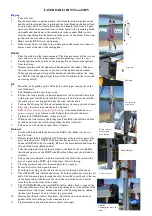
Functional Description
10/2003
Operating Instructions SRIF 2002
Page 14 of 33
3.1 Radio
transmission
The SRIF 2002 comprises all necessary functions for the transmission of digital
data in the 5.8 GHz range in transmit and receive mode. It is possible to set 127
frequencies (channels) independent of each other. The channels can either be
programmed via an additional asynchronous interface (UART protocol: 4800 Baud;
8N1) or set via 7 binary-coded parallel control lines. The parallel setting always has
priority, i.e. a serial programming is only possible if the parallel interface is
disconnected or the word “0” is set at the parallel interface (all switches open). The
SRIF 2002 supplies an analog RSSI signal.
The SRIF 2002 operates in the half duplex mode. The SRIF 2002 is in the receive
mode as a standard. As soon as any transmission data are applied to the data
input (TXD) and the control signal pin2 is set to TX, the module switches to the
transmit mode and transmits the data.
Figure 2: Schematic representation of the radio transmission
Operating modes of the SRIF2002:
●
Receive
mode
The receive mode is the normal operating state of
the module.
●
Transmit
mode
The module automatically changes into the
transmit mode when a valid signal has been
received via the UART and after the completion of
a just received block via the radio path.
●
Stand-by
mode
The stand-by mode is activated at wrong
parameterization.
TxD
RxD
SRIF 2002
SRIF 2002
TxD
RxD
5.8 GHz ISM band
Summary of Contents for ECOS SRIF 2002
Page 1: ...ECOS SRIF 2002 Operating Instructions Edition 10 2003 ...
Page 4: ......
Page 10: ......
Page 12: ......
Page 26: ......
Page 28: ......
Page 30: ......
Page 33: ...Operating Instructions SRIF 2002 Page 33 of 33 this page is empty ...















































